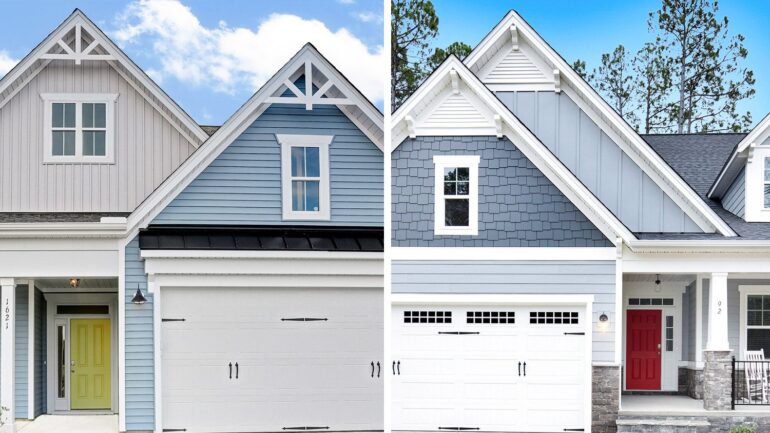Introduction
Choosing the right siding is one of the most important decisions a homeowner can make when it comes to protecting their property. Siding isn’t just about appearance; it plays a critical role in defending your home against weather, pests, and energy loss. With so many options available, it can be difficult to know which material will provide the best long-term performance.
Among the most popular choices are vinyl siding and fiber cement siding. Both are widely used across the country, but they differ significantly in terms of cost, durability, maintenance, and overall protection. Making the wrong choice can lead to higher expenses, frequent repairs, and a less efficient home.
That’s why companies like Uncommon Roofing and Siding help homeowners weigh the pros and cons of each option. By understanding the strengths and weaknesses of vinyl and fiber cement, you can choose the siding that best fits your home’s needs and your budget.
Vinyl Siding: The Affordable Favorite
Vinyl siding has long been one of the most commonly installed siding materials in the U.S. Homeowners often choose it because of its affordability, wide variety of colors, and ease of installation. Vinyl siding panels are lightweight, which means installation is typically faster and less expensive compared to other materials.
From an appearance standpoint, vinyl siding offers plenty of flexibility. It comes in a range of styles, including options that mimic wood grain or shingles. For homeowners looking for a budget-friendly upgrade that boosts curb appeal, vinyl remains a popular choice.
However, vinyl does have some limitations in terms of long-term protection. It is less resistant to impact damage from hail, branches, or debris. It can also warp under extreme heat or crack in very cold temperatures.
Fiber Cement Siding: The Durable Challenger
Fiber cement siding has grown in popularity due to its impressive durability. Made from a blend of cement, sand, and cellulose fibers, it is engineered to withstand harsh weather conditions, pests, and even fire. Unlike vinyl, fiber cement won’t warp in high heat or become brittle in freezing temperatures.
A major advantage of fiber cement is its longevity. With proper maintenance, it can last 30–50 years or more, making it a worthwhile investment for homeowners planning to stay in their homes long-term. It also offers a more natural look that closely resembles real wood siding, appealing to those who value aesthetics as much as durability.
On the downside, fiber cement siding is heavier and more difficult to install, which makes labor costs higher. It also requires repainting over time, whereas vinyl siding retains its color without the need for painting.
Cost Comparison
For many homeowners, cost is a deciding factor. Vinyl siding typically costs less upfront, making it a more budget-friendly choice. The lower material and installation expenses can be appealing, especially for those completing large exterior renovations.
Fiber cement siding, while more expensive, provides long-term value through durability and reduced need for replacement. Homeowners must weigh whether they prefer lower initial costs with vinyl or greater longevity with fiber cement.
Maintenance Considerations
Maintenance needs differ significantly between the two siding types. Vinyl is virtually maintenance-free; occasional washing with soap and water keeps it looking fresh. It never requires painting, which saves both time and money.
Fiber cement siding requires more upkeep. It must be repainted every 10–15 years to maintain its protective finish and appearance. However, with this maintenance, it can outlast vinyl by decades. Homeowners willing to commit to periodic painting often find the trade-off worthwhile for the added durability.
Weather Resistance
Climate plays a big role in siding performance. Vinyl siding performs well in moderate climates but may struggle in extreme conditions. Intense sun can cause fading or warping, while freezing temperatures can make it brittle.
Fiber cement siding, on the other hand, holds up in nearly any climate. It resists swelling, cracking, and warping, even under dramatic temperature swings. For homeowners in storm-prone or high-humidity regions, fiber cement often proves to be the safer choice.
Energy Efficiency
Neither vinyl nor fiber cement siding is a major insulator on its own. However, insulated vinyl siding options are available, which add a layer of foam backing to improve energy efficiency. This can help reduce heating and cooling costs by providing extra resistance to heat transfer.
Fiber cement siding doesn’t offer insulated versions, but when combined with proper wall insulation, it creates a highly protective barrier. The material itself is dense, which adds some thermal resistance, though not as much as insulated vinyl.
Environmental Impact
For eco-conscious homeowners, the environmental impact may also influence the decision. Vinyl siding is made from PVC, a plastic material that is not biodegradable and is energy-intensive to produce.
Fiber cement siding, while also energy-intensive to manufacture, is longer lasting, meaning fewer replacements over time. Its extended lifespan can make it a more sustainable choice for those prioritizing durability and reduced waste.
Choosing the Right Siding for Your Home
Ultimately, the decision comes down to your priorities. Vinyl siding offers affordability, easy maintenance, and versatility in design. It’s a solid option for homeowners on a budget or those planning to sell their home in the near future.
Fiber cement siding offers unmatched durability, better weather resistance, and a more natural appearance. It’s ideal for homeowners who want long-term protection and are willing to invest more upfront. Working with an experienced contractor ensures the siding is installed correctly, maximizing its performance and lifespan.
Conclusion
Both vinyl and fiber cement siding have their advantages, but the right choice depends on your home’s location, budget, and long-term goals. Vinyl may save money in the short term, while fiber cement delivers superior durability and protection over decades.
For guidance tailored to your home and climate, working with professionals makes all the difference. Uncommon Roofing and Siding helps homeowners evaluate their options and choose siding that balances affordability, aesthetics, and performance for lasting protection.






